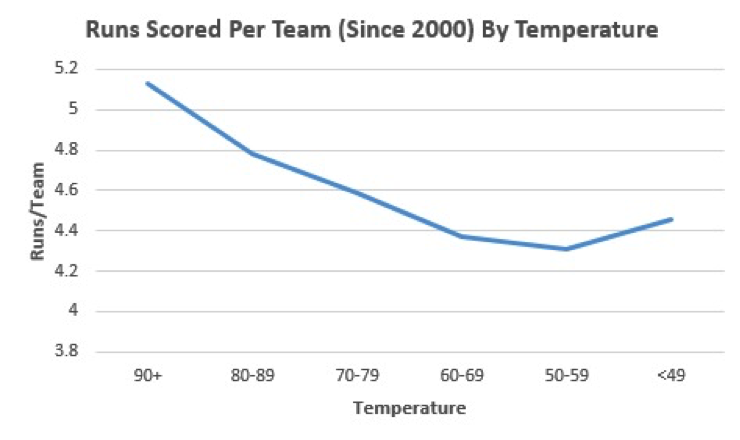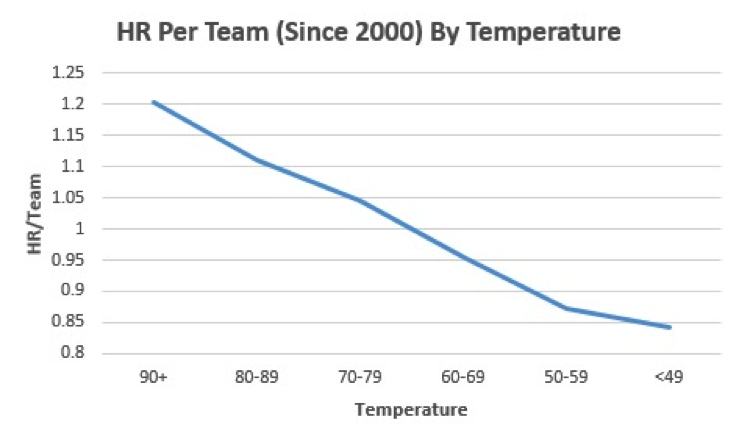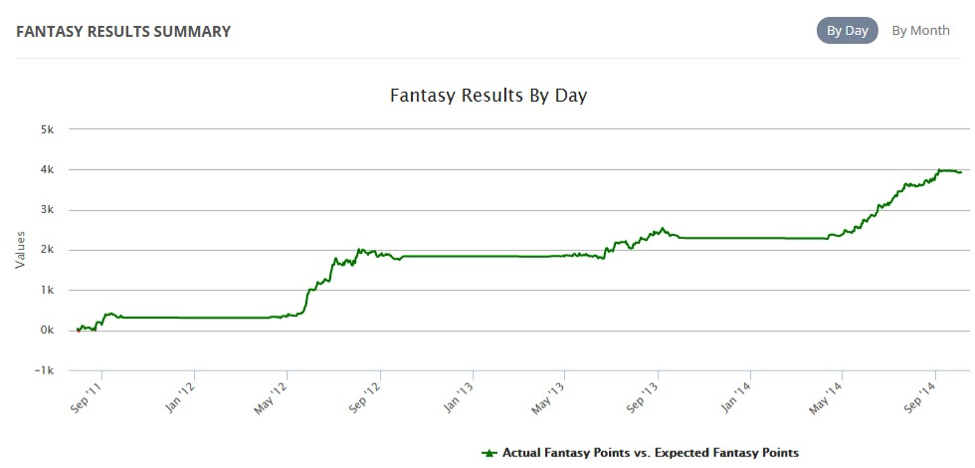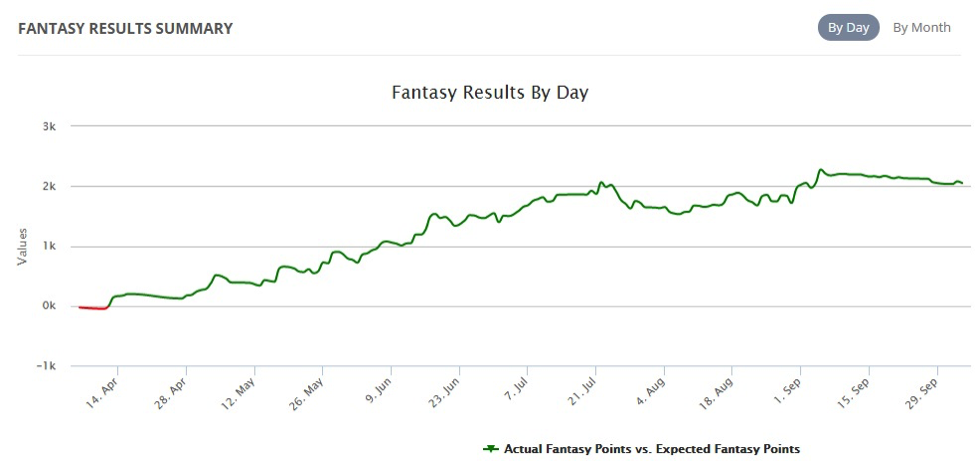The Impact of Temperature on Fantasy Baseball Scoring
I’m almost 30, but I still have a bedroom in my mom’s house. In that room is a collection of trophies, ribbons, and game balls (nbd) from when I played Little League. I tried to display my collection in my apartment, but my girlfriend claims “that’s immature.” She also brushes her teeth in the shower, which is just bananas to me, so I don’t take anything she says too seriously.
My favorite item in that room is a game ball from when I was a key member of the world-famous Topton Pirates. I threw a no-hitter in an early-October game. The Topton record books don’t “officially” label it as a no-hitter because I gave up a line-drive off the wall to the first batter of the game. Our left fielder took a step in when that ball came off the bat and he ended up barely letting it sail over his head, though, and when that’s the only hit you give up in a game, it becomes an error.
I called that first-inning shot off the wall an error around the fifth inning because I hadn’t given up another hit and it became obvious what I had to do. So once we reached the bottom of the sixth (the final inning) with two outs, I knew I needed one more out for my fictitious no-hitter.
Up by just one run with a full count on the batter, I decided to do the selfless thing and just throw a ball to walk him so I didn’t ruin my no-hitter-that-no-one-else-knew-was-a-no-hitter. So I threw a nice easy pitch way up in the zone that I knew Daryl (the batter’s name was Daryl—I’m confident he won’t ever read this) wouldn’t swing at. And by “way up in the zone” I mean “fuck I just threw a 35mph pitch right down the middle of the plate.”
Daryl swung, and Daryl connected. It was a towering fly ball to right field—luckily not to left where that asshat Daniel Roberts ruined my perfect game bid in the first inning—and I was sure it was gone. Our right fielder backpedaled, then started sprinting…to the track…to the wall…going, going, OUT! He made the catch and my no-hitter was saved!
The moral of the story? Listen when I reminisce about Little League because I clearly don’t have much else going, guys. I still display my trophies for Christ’s sake. The other moral of the story…the temperature matters a lot in baseball.
You see, October in Pennsylvania is cold. It was maybe 40 degrees that night. You might think that wouldn’t have a massive impact on the outcome of a fly ball in a Little League game, but you’d be wrong my friend. Numbers suggest that if it were even 60 degrees that night, that ball would have gone over the fence. I was saved by depressed molecule speed.
Temperature and Fantasy Scoring
In my book Fantasy Baseball for Smart People: How to Profit Big During MLB Season, I published some research on the importance of temperature in predicting offensive upside. Here’s a look at the number of runs scored per team since 2000, broken down by temperature.

When the temperature was very hot—over 90 degrees—teams scored around 13 percent more runs than when the temperature was between 70-79 degrees and 18 percent more runs compared to when the temperature was between 60-69 degrees. That’s a pretty substantial jump based on a factor that a lot of daily fantasy baseball players don’t even consider. Would you really think 90 degrees is that much different than 70 degrees?
There’s a very linear relationship between temperature and home runs, too.

Since 2000, teams playing in 90-plus degrees have gone deep 26 percent more often than those playing in temperatures of 60-69 degrees and 38 percent more frequently than those playing in temperatures of 50-59 degrees. There’s a huge potential edge here that you can exploit by emphasizing nothing more than how hot it is outside.
Temperature and Fantasy Value
One of the most overlooked aspects of winning daily fantasy sports is the difference between player value (as in what will increase fantasy scoring) and site-specific value (as in what traits are most valuable for certain fantasy sites). This all comes down to what’s “priced in” to salaries. It’s possible that a certain angle might lead to fantasy production—like rostering players in games with a high projected run total—but DraftKings or FanDuel could account for that variable in their pricing such that there’s no usable value. Or maybe one site cares more about Vegas (or temperature, or the ballpark, or whatever) than another, and that’s important information to know.
The problem is it’s difficult to determine exactly how sites price players. There are so many inputs each day that it’s challenging to know if a player’s price has truly jumped because of the temperature, for example, or because of splits, Vegas lines, or some other factor.
Well, I’ve been working on a new site called FantasyLabs.com that uses historic salary data and fantasy results to allow users to spot trends and quickly identify what’s not “priced in” to player salaries on various sites. It’s awesome.
So do daily fantasy sites account for changes in temperature in their pricing? Maybe indirectly, but not as much as they should. Here’s a look at the historic value of players in games that are played in at least 80-degree temperatures. The line represents the difference between those players’ fantasy production on FanDuel and what we’d expect from all players with the same salary, i.e. if a $5,000 batter on FanDuel should be expected to score 5.0 fantasy points, but he scores 6.0 points when the temperature is above 80 degrees, that would be a +1.0 per game value.

You can see that the value here has been positive in each of the past three seasons, meaning FanDuel doesn’t fully account for the increased value of warm temperatures.
If we add it all up, we see that batters in the warm games outperform all batters by 0.12 points per game on FanDuel, which ends up being around 6.2 percent of expected production.
It’s important to keep in mind that this number factors in site pricing. If FanDuel increased the price of players in games of at least 80 degrees, for example, we could very well have a negative value because the expected points (based on salary) would increase.
We’re looking at production over expectation, which suggests that FanDuel doesn’t price hitters according to temperature, at least not as much as they should.
The same is true of DraftKings, too. Here’s a look at the same graph from last season.

Overall, players in “warm” games have exceeded expectations by 0.22 points per game. The expectation for all batters on DraftKings is higher than on FanDuel because of differences in the sites’ scoring systems, so the increase of 0.22 points represents only a 3.8 percent increase over expectation.
And just like that, we’ve found that, when it comes to temperature, DraftKings prices players more efficiently than FanDuel. This is subject to change, of course; maybe FanDuel will make temperature a bigger component of their pricing model moving forward, for example.
Ultimately, though, both sites misprice players relative to the temperature of games, which means this is a very exploitable inefficiency when it comes to one very simple number in daily fantasy baseball.